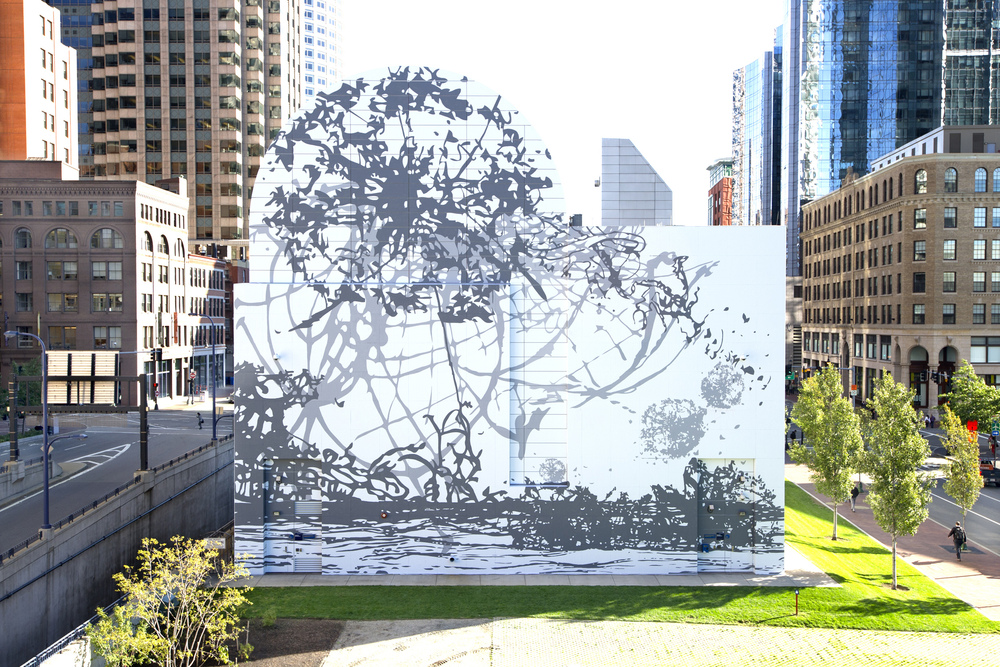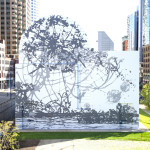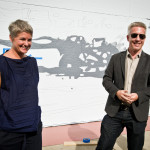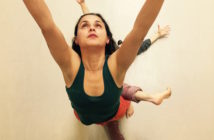Ben Sloat My first question is about artistic research. I teach here in Boston in a couple of graduate programs and I’m always interested in sharing the rubrics of research with the students: what the methodologies of research are, what are the goals, how are things modified, and I am wondering in terms of this project, what your research entailed?
Matthew Ritchie You started with the big question right?
BS Well we have only a few minutes so we might as well go for the gold right?
MR I think there are two angles that I stress with because I teach at Columbia, and I stress the importance of research, especially outside your field, because there’s a tendency to look for the closest thing. But I also stress in the methodology of research something that’s really emergent something called cognitive bias; the kind of bad habits of research, so I also try and stress for them, and for myself, a kind of intuitive response to the site.
The two things want to be really closely aligned because it's very easy to go off on a footnote essentially, and convince yourself that you’ve found the most important thing about a site. So something like this, which is a public engagement, I try to be really specific about. That it’s dealing with the most obvious things first; like it’s outside, it’s by the water, there are birds, there are people . . . There are all these site factors that shouldn’t be overlooked in a kind of research notion.
Research is kind of like: Imagine if you started researching cancer, but we don’t even think about this cancer stuff, because I’ve discovered this really interesting furniture. Pretty sure it’ll get us back to cancer eventually.
For public art, it tries to relate to what remains of, kind of, the human project. You gotta nail the big stuff as part of it, whether or not you’ve been introduced to these other themes, so then the other part of my project is to introduce all of these personal research—I’m not ever entirely sure is or is not totally specific to the project itself. So there’s a lot of iconography and imagery here that’s from me and from my life. And then the third part of it is you can say "Well," then I think, "once you’ve addressed those two kind of major biases, then you can start to introduce like specific subsets of research, and test them against this;" things that occur to you along the way—they can often really start to inform the other two so you have a kind of triangle of research.
And those three things, to me, match Charles Pierce’s triangle of how diagrammatic influence is constructed. You have induction or intuition, deduction or analysis, and then you have abduction where you start to take things away. So that’s really how I approach most of my projects.
BS Along those same lines, one thing we talk a lot about in schools—and since a lot of people who read our Journal are local art students and teachers etc.—we always talk about the difference between why the work is made versus what the work does, and that always seems to be one of the greatest translations for a student to cross . . . I’m wondering if you could talk about, for you, and your practice, that sort of translation?
MR I think I’m sort of surprised by those things. I try and build that in. I try to build an open operating system, in a way, for myself, but it also doesn’t become totally not specific. So again I think its like a lot of the difficulty students face particularly is they have presented with a lot of binary choices, so they have "it’s this" or "it’s that," it’s a sign or it’s a signifier, and that it’s really more of a triangle, that third part is always the object, but its always those three things working together that make that floor space, it’s like a little pyramid, the three sides of a base that make a point, and that’s what the other person sees.
BS I guess I’m speaking specifically about the piece I bring my students to every year which is the Games of Chance and Skill at MIT. We leave the MIT chapel, and spend time with Eero Saarinen, then we go into this very public interaction, where we see these three iterations, so I’m interested in the materialized transition between the cut wall piece, and the light, and then the glass, which is always incredible because every time we’re there it becomes an event. There’s always people in the swimming pool on the other side of the glass who think we’re looking at them, and then they feel objectified.
MR Yeah, though I am not one of the relational aesthetic artists, I am very much of that generation, so I think I grew up with the same sort of ideas about wanting things to be both in and out of the art world, and being frustrated that there was this nominal divide. I think that the approach that I take is very different in that I want that engagement to be perpetual, so I tend to work directly with a discipline. So with something like the MIT thing, its like I was in consultation with the architect, rather than as an aesthetic gesture. So there’s a different notion of aesthetics because you are, as you said, it’s much less controlled, it’s much more real in some ways—its a real swimming pool, its not an art swimming pool, and people are really just swimming in it, so by making a gallery to that. And then saying the diagram on the wall, is hypothetically, if you dive from the high board, we modeled it on the computer so that in the middle of the dive, if you turn your head, it lines up perfectly with the piece on the back wall, so it’s a little camera obscura, but of course you would break your neck—you have no time to do that—so its a totally hypothetical engagement with a moment of possibility. So there’s no solving the puzzle. In the computer you can line them up, and the light box is a kind of solution in a way, of the two things.
BS And for the light box you need to look up, and to keep moving.
MR And you can’t see that either because the wall is slightly curved and all the factors there are rendering it impossible, which is a thing about—I don’t want to say it’s an engagement with the idea of MIT as the place where problems are solved, because there are problems that MIT can’t solve , such as a curved wall and window—it’s a problem in physics that can’t be solved. And the diagrams are all Newtonian physics, which is what’s happening in the pool. It’s just shows you all the equations, just basic physics of motion.
BS But you also seem so interested in chance, and the unpredictable outcomes. I remember the big installation at MASS MoCA, and I remember throwing these dice, and then video was engaging with it . . . I’m always struck by how systematic a lot of the work is, but that it embraces this whole other out-of-control aspect too. Which is sort of like what is happening here in Dewey Square. I am wondering about the guy in that office looking at this work every day is going to have a whole other relationship to this than the guy on the street and that type of thing.
MR Yeah, and this is going to change, you can already see that whatever time of day it is is going to feel very different. In the winter it’s going to feel very different than the summer. I think that is all part of the very vexing question of what art does when it tries to enter the world—when it steps just outside its comfort zone. I don’t have the answers, I’m just really interested in whether it can be done effectively. In New York we have a lot of public art, but a lot of it is essentially playground furniture for adults, and often even just for children—brightly colored with rounded edges—and you’re like "is that actually solving the problem?" I prefer to think that we can do something a bit more interesting.
BS And what problems do you see yourself trying to solve?
MR Well, this notion of complexity in the public sphere. There’s a tendency to think that the only way people will be happy is if they behave like babies, build them a playground a give them sugary drinks—which is true, of all of us, we all love a nice, warm, cushiony environment—but that doesn’t solve the public sphere. We know that the public sphere is not a nursery, it’s for adults to do adult stuff in, but how do we nudge the needle a little bit, you know? I wouldn’t say that my engagement with systems is terribly simple. I would say it’s more like the question of the casino, where it seems like there’s a lot of complexity and risk but actually it’s totally rigged. You go to a casino and they’re like, somebody said the phrase "Thank you Sir" is actually "Good Night Sucker," when it’s translated. . .
BS It’s also about an experience that seems simple, but in fact is highly staged and incredibly complex. I think about that in terms of your work. I like re-approaching it and seeing different iterations of it and having you push me as a viewer to feel challenged. Could talk about that, and your intention toward this residency at the ICA?
MR I guess I’m always arguing for the engagement with complexity. Not that it should be complicated, but that we have to acknowledge the richness and complexity of art, and everything, in general. And we have limits—for one person, it’s like Os Gemeos mural is too much, for another it’s too easy, you know? There’s no way of setting any kind of metric on that.
So once you know that this is a kind of statistical game that a certain number of people are going to enjoy a certain amount of pushing. There’s the person who only likes minimalist work, somebody who likes gray, and someone who likes brightly colored things . . . We’re all in it together, right? We can’t be, I think we’ve gotten past the point where there’s a "right way," so I’m just trying to gauge people in multiple ways to show them that, each one of those micro-audiences that there’s a contiguous—in this particular project for the ICA, it moves from a painting right now in the gallery that is the first part of the project, that has a little film that goes with it that no one knows is already there, and then this will have an animation that goes with it that plays music, that is very much here, and there’ll be seven of these, and then there’ll be some performances, and then a bigger extension of this mural in the ICA lobby that will turn into a wall of glass.
And they’re all temporary engagements with modes of the building, and what the ICA is doing, which is trying to be; its a funny word, we use this word contemporary, and what exactly does it mean? You know, we use it very freely, but does it mean "of the now," or "against the temporary?" We haven’t really decided what contemporary art is so the Institute of Contemporary Art . . . Its a super complicated engagement, so I’m interested on the level of the fugitive, the enduring. Like some people will come to a concert, and if you can tell them that "what you just saw is a painting," then they’re going to be like "what do you mean by that? How can a concert be a painting? How can a song be a painting?" We’re like "Why can’t it be?" I mean, given that we’ve broken down every category—supposedly—then there’s all these sort of legislated differences where it seems interesting to tell what’s the boundaries that constitute what is an art-concert versus a real concert? An art performance piece versus going to the theater? People of the theater don’t go "actually we’re doing art," artists often are "doing theater." I have no answers to all of this. I think this project is about trying to do all the possible things that can be done, over a period of time that allows them to be held in relationship to each other without forcing any conclusion.
BS So that to me relates a lot to the German word Gesamtkunstwerk, the Wagner idea of the ‘total work of art,’ and I’m wondering if some of the challenges are the contemporary viewers’ relationship to materiality? Like things are so virtual that a lot of the freshman students have never used an analog machine. They don’t know how to raise and lower a photo enlarger, they have no skill set for that any more. So I’m wondering if part of that gesture is kind of to re-infusement of different materialities or to kind of touch different bases that people might . . . that are so specialized that, to kind of complicate that is actually a very generative process.
MR Yeah, I think I’m opposed to the Gesamtkunstwerk. I think it’s one, probably just impossible, but two, I don’t think I would like it even if it was possible. I think the opposite of that is something like Schwitters’ Merzbau that ironically was coined as the Gesamtkunstwerk, but it’s really just a giant collection of garbage. It kept changing, and it kept being rebuilt and rebuilt. It was a totalizing gesture, rather than a finished, completed, totalized work.
Of course it’s hard to make that distinction, one tends to become the other with history once time passes. Like that is a Gesamtkunstwerk because it’s finished, but while it’s being made, it should never feel like there’s some kind of totalizing gesture. Instead it’s an opening. The total gesture is one that opens the world. The idea of the total artwork is a dead artwork, one that closes the world.
So I’m for the largest possible sequence of open gestures with the largest possible proliferation of meaning inside that. As opposed to the fixed sort of table or the rigid rule set where you nail it all down. So that is always the objective. The object can never be finished, that’s why it’s so important. You can never have it set so that the program is done, but you can have that sort of Photoshop metaphor, the seventeenth layer and its "done," resolved.
Like when we were up there on this mural, it’s a disgrace up there—missing lines and unfinished—you can’t see any of it. And if you go to Sistine Chapel in Florence, Michelangelo’s masterpiece, you see all the floor tiles—they’re about as well painted as this—big brushy marks, but if you see it in a photo, it looks perfect. And I think that’s the illusion of the mediated space. What is the point at which the artist has chosen the process as opposed to some kind of programmatic tool? And that is really where the object always raises this kind of . . . and in a way, you don’t want to sound essentialist, but the least number of things that are stolen or borrowed, and I think this is endemic to the illusion of film.
People think that film is spontaneous and intuitive, but it’s not, it’s actually a taking of all of the resources that were presented in front of the camera. Its a very receptive, and apparently intuitive technology, but that leads you to the computer which is that times a thousand, where even the gesture itself is mediated. I use computers to do what they can’t do, I sort of teach them to fail, which is kind of also what they wanted and they’re really sort of fragile and we’ve all experienced that.
BS Well I think Picasso said "Computers are so limited. They only give us answers."
MR Yeah, exactly.
- Matthew Ritchie, Remanence: Salt and Light (Part II), 2013 Photo Geoff Hargadon
- Jenelle Porter and Matthew Ritchie. Photo Geoff Hargadon
Special thanks to mural collaborator Tricia O’Neill!






